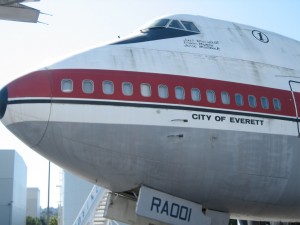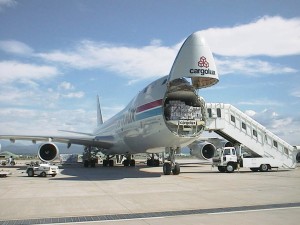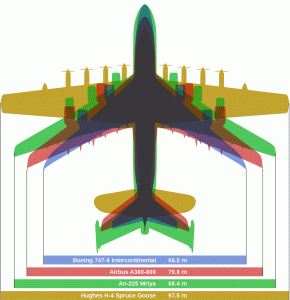Published on September 10, 2012
In a comedy routine alluding to the famous Amos & Andy, late one night an Eastern Air Lines flight crew radioed Miami Center’s route controllers, “Say Amos, why DO the 747 have a bubble on the top?” Playing along, the controller replied “I dunno Andy, why DO the 747 have a bubble on the top?” “Well, said the Eastern pilot, “thay’s so the pilot has gotz enough room to sit on his wallet!”
Today in aviation history in 1993, the Boeing Company rolled out the 1,000th example of its revolutionary and unique design, the B747 Jumbo Jet. By 1993, the aircraft had been production for 26 years (this year marks the 45th year of steadily improving variants). In that time, the B747 has emerged as the dominant wide body airliner design in the world, an icon of the entire industry. Yet what single characteristic sets the B747 apart from all others? The answer is simple — the hump-like feature caused by the forward section’s upper deck and cockpit. The surprising thing, however, is that the B747’s characteristic hump was born not of some designer’s brilliance, but rather because the jet was designed originally for cargo only. Failing that, it was then relaunched as a passenger plane into an industry-wide misconception about the future of the airline industry. Believe it or not, Boeing expected that the B747 design was but a temporary stepping stone in passenger air travel that would soon wind up as just another tired old, cargo plane.
They couldn’t have been more wrong and yet still somehow have gotten it so right.

The History of the Design
For Boeing, the B747 design was born not from the passenger engineer’s drawing board, but rather as Boeing’s design in competition for the USAF’s large cargo aircraft requirement, the April 1964 “Heavy Logistics System” requirement. The RFP would be successfully won by Lockheed with its revolutionary C-5 Galaxy design. As a key competitor, Boeing had bet it all on their design and, having lost the bid, elected to take the B747 in a different direction, hoping to serve passenger needs among the leading air carriers while also thereby recovering at least part of its losses from the failed USAF competition. Even when converting the design to passenger operations, many of the cargo design features were retained — among them, the famous hump.
The reason for the hump was due to the rise of intermodal cargo concepts worldwide, where containers were packed up at the factory, hauled by trucks to ports and then loaded onto ships or placed onto rails for overland travel. Boeing’s designers were struggling to fit the cargo intermodal model into the air transportation context. While it was clear that the sea containers were too heavy for air transport, it seemed equally clear that a similar size and shape would likely evolve for air transportation, but of lighter materials. The key measurement was viewed as the 8 foot standard highway truck height. This same dimension also had been applied successfully to shipping and rail, so it seemed logical that it would be applied to air as well.

For the designers, this posed a problem. A front-loading aircraft capable of taking in a 8 foot high “air container” (for lack of a better term) was impeded by the presence of the cockpit in a traditional airliner layout. For the B747, a nose-loading large lift door was envisioned and to make the cockpit lift with all of its control cables, electrical connections and hydraulics, would be challenging, expensive and a clear recipe for maintenance problems. Not only that, if the cockpit raised and flipped backward for loading, the crew could no longer be inside performing normal cockpit functions while the nose door was open.
The designers therefore decided on a revolutionary idea, to make a second, shortened deck in the front third of the plane that would be above the 8 foot height of the cargo hold and, when the nose lifted for loading, the upper deck would remain in place and horizontal. Further, the required large air conditioning and pressurization units could be placed behind the cockpit on that upper deck, clearing more space on the cargo floor (or, as it was envisioned, space for more passenger seats).

When Lockheed won the USAF heavy cargo plane bid, Boeing was left with converting the B747 Freighter to a passenger configuration. Based on the company’s longstanding relationship with Juan Trippe at Pan Am, that airline agreed to become Boeing’s launch customer. Pan Am then offered that the air conditioning units should be repositioned below the main deck so that the hump area behind the cockpit could be turned into a first-class lounge. It was an idea that heralded from Pan Am’s storied days of flying boats and Trippe and his senior management were right about the marketing potential that an upper deck lounge would bring. Boeing agreed and the upper deck became a first class facility, complete with a bar. Other airlines joined Pan Am in acquiring the B747, even if the entire industry looked to the plane as nothing more than a stop gap measure on the path to something far greater — the SST.

The SST and the Boeing 747
At the time, the entire airline industry was united in its view that passengers would be soon traveling exclusively on supersonic transports (SSTs). Why would anyone buy a ticket to Europe for a nine hour trip when an SST ticket could be purchased and one could leave New York in the morning and arrive in Paris just a few hours later? In fact, most airline executives felt that a working SST would enter the market and transform the industry within just five years. In that light, retaining the B747’s hump was a wise design move — the airlines could easily resell the outmoded subsonic B747s to cargo carriers since the upper deck would allow relatively easy conversion to a freighter role, where the aircraft could easily dominate that industry as well.

The problem was that everyone was wrong. The American SST never made it off the drawing board into industry. Europe’s SST, the Concorde, proved costly to operate and was a fuel and maintenance hog — though it was the fastest, most streamlined arrow-shaped hog in history. With higher operating costs and fewer seats, the Concorde’s ticket prices had to be heavily subsidized by the operators’ governments — yet even there, the ticket price rivaled the cost of going first class. Thus, one could pay a prince’s sum to be in Europe in a few hours, strapped into a narrow, restricted tube-like fuselage of the Concorde with minimal services — or one could pay the same, or even less, and have an eight or nine hour trip in luxury, feted by beautiful flight attendants serving champagne, foie gras and grapes in the upper deck lounge. For passengers, the choice was obvious. Even economy coach passengers approved of the B747, since it meant ticket costs to Europe were soon at record low prices.

The Boeing 747 Today
Long after its projected five year passenger service life, today the Boeing 747 Jumbo Jet remains in wide use around the world. For most leading air carriers, their 747 fleets are their crown jewels, affording passengers space and comfort, while bringing extraordinary economies of scale that make traveling to Europe by air more affordable than ever before in history. Now in its 45th year and still going strong, the B747 has evolved into today’s wide body wonder — the 747-8, which dwarfs the original capabilities and efficiencies of the first generation of 747s all those years ago. What the future holds against the new Airbus A380 and the Boeing 777 Dreamliner is still unclear, but it what is known is that by the time 2013 is past, Boeing will have reached a new benchmark with 1,500 of their 747 aircraft delivered to buyers around the world.
And thus, the hump-backed “Queen of the Skies” has come along way from a one-time cargo plane design that nobody thought would make it through its first half decade.
One More Bit of Aviation Trivia
The largest wide body jets of today include the B747, B777 and Airbus A380. Costing hundreds of millions of dollars and seating 400 and 850 passengers in each plane, these designs have not only transformed the industry in the air, but as well on the ground. Air terminals worldwide at leading hubs have had to undergo major transformations and reconstruction to handle the volumes of passengers carried on each flight. Customs, passport control and security stations have been expanded. Waiting areas have been enlarged. Baggage handling, check-in and baggage pick-up areas have been modified and expanded as well. Restaurant facilities have been added and emergency support, ambulances and medical care have had to adjust upward accordingly. Ground services contracts have been increased as have fueling facilities. A new generation of First Class and Business Class Lounges have been installed, signalling a significant upgrade as well in off-the-plane services due to rising expectations. Hundreds of millions of dollars have been spent on the ground just to handle the ever larger passenger counts. And in the end, the business of international passenger aviation has never been larger or more quickly growing than ever in history. Yet it remains a quandary, why are so many air carriers still losing money?
Today’s Aviation Trivia Question
What were the aerodynamic effects of the B747’s famous hump? Did it increase or decrease performance?

Don’t know about the aerodynamics of the 747, but my father flew the transonic Convair 990. He told me that the nacelles on the tops of the wings, which allegedly enabled smoother airflow at he transonic region, were called “speed bumps” by the pilots – particularly those who had flown the bump-less Convair 880
The aircraft was designed to carry standard intermodal containers in a two-wide, two-high stack on the main deck, which was considered a serious accident risk for the pilots if they were located in a cockpit at the front of the aircraft. They were instead moved above the deck in a small “hump”, which was designed to be as small as possible given normal streamlining principles. It was later realized that the drag could be reduced much more by lengthening the hump, using it to reduce wave drag offsetting the tail surface’s contribution. The new design was introduced on the 747-300, improving its cruise speed and lowering drag, with the side effect of slightly increasing capacity on passenger flights.
ref: https://en.wikipedia.org/wiki/Area_rule
In 1964, there was a “Heavy Logistics System” requirement. The RFP was successfully won by Lockheed with its revolutionary C-5 Galaxy design. The project was dual-awarded to Lockheed and Boeing.
As a key competitor, Boeing had bet it all on their design and, having lost the bid, elected to take the B747 in a different direction, hoping to serve passenger needs. Their goal was to market the plane to the leading air carriers and thereby recover at least part of its losses from the failed USAF competition.
As it happens, about 100 C-5s were built in all — as for the B747, far more have been built since the first commercial launch. Today, Lockheed is essentially out of commercial aviation. Boeing may have “lost the battle, but it won the war”, emerging as the single surviving (and prospering) US-based commercial wide body jet airline supplier — facing only Airbus as a key international competitor these days.
The original origin of the ‘bubble’ is disputed. This may be still a Boeing trade secret and not known within the Boeing public relations group. The freighter aspect took advantage of the bubble.
I have never seen published the true purpose of the ‘bubble’ but without it, but without it there would be an unresolved AD. This includes the great book Fly 747 by Sutter. The bottom line is “Boeing does care.”
I learned the story from a Boeing engineer when the issue was first discovered. I do find it strange other planes do not have a ‘bubble.”
Enjoy sorting out the true story.